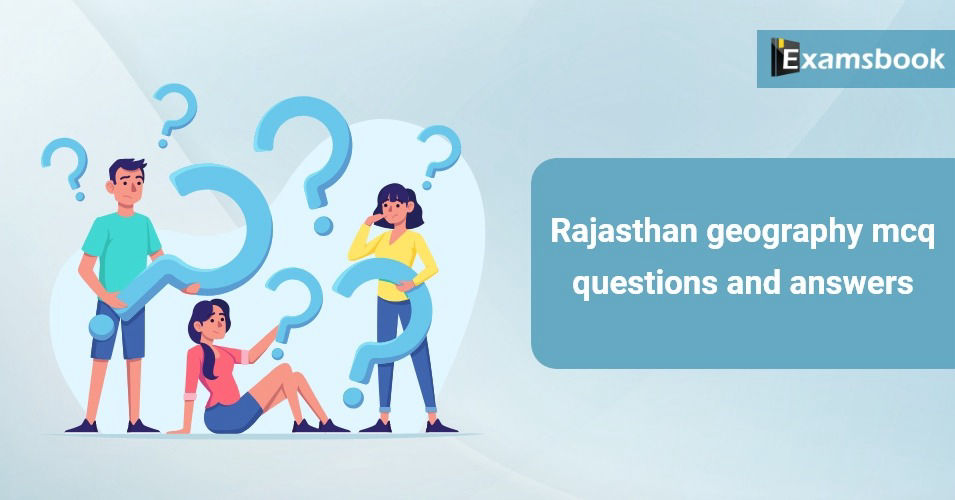Rajasthan Geography MCQ Questions and Answers

Welcome to the Rajasthan Geography MCQ Questions and Answers blog! This Rajasthan Geography MCQ Questions and Answers blog is dedicated to providing a comprehensive collection of multiple-choice questions (MCQs) related to the Geography geography of Rajasthan, a state located in northern India. If you are a student preparing for competitive exams, such as state-level or national-level entrance tests, or if you simply have an interest in Rajasthan's geography, this blog is the perfect resource for you.
Rajasthan Geography MCQ
In this article Rajasthan Geography MCQ Questions and Answers, we have covered carefully curated collection of MCQs covers various aspects of Rajasthan's geography, including its physical features, climate, rivers, wildlife, historical sites, and cultural heritage. Each question is designed to test your knowledge and understanding of Rajasthan's geography, and the accompanying answers provide detailed explanations to help you learn and reinforce your understanding.
Start practice with Rajasthan Test Series to conquer the Rajasthan Exams.
Rajasthan Geography MCQ Questions and Answers
Q : Match the following and select the correct answer from the code given below - List - I Region List - II Peaks ( A ) North Aravalli ( i ) Tadgarh/Todgarh ( B ) Middle Aravalli ( ii ) Satur ( C ) South Aravalli ( iii ) Dilwara ( D ) Hadoti Region ( iv ) Raghunathgarh Code - A B C D
(A) i iv iii ii
(B) ii i iii iv
(C) iv i iii ii
(D) iv ii iii i
Correct Answer : C
How much share of the center and the state has been kept for the financial arrangement of the Drought Prone Area Programme (DPAP) operated in Rajasthan?
(A) 50:50
(B) 60:40
(C) 75:25
(D) 90:10
Correct Answer : C
Explanation :
1. The Drought Prone Areas Programme, was started in 1973, as a centrally sponsored program as an integrated area development programme.
2. Central and state governments share the cost in the ratio of 75:25.
Which of the following is not a proposed beneficiary district of Indira Gandhi Nahar Project (IGNP)?
(A) Pali
(B) Sikar
(C) Nagaur
(D) Jodhpur
Correct Answer : A
Explanation :
1. Pali does not get drinking water from the Indira Gandhi Canal Project.
2. This canal passes through seven districts of Rajasthan which include Barmer, Bikaner, Churu, Hanumangarh, Jaisalmer, Jodhpur and Sriganganagar.
Where was the first cement factory established in Rajasthan?
(A) Lakheri
(B) Dabok
(C) Beawar
(D) Gotan
Correct Answer : A
Explanation :
The first cement factory in Rajasthan was established in Lakheri (Bundi). This factory was established in 1915 by the Associated Cement Company Limited (ACC). It is the longest-running cement factory in Asia. In 2022, ACC became part of the Adani Group.
What is the place of Rajasthan in the production of groundnut in India?
(A) Second
(B) First
(C) Third
(D) Fourth
Correct Answer : A
Explanation :
Rajasthan accounts for 16.27% making it the second largest state in groundnut production in India.
Which of the following (Irrigation Project - District) is not matched correctly?
(A) Savan-Bhado - Kota
(B) Som Kagdar - Udaipur
(C) Parvan lift -Jaipur
(D) Som-Kamla-Amba - Dungarpur
Correct Answer : C
Explanation :
All of the following (Irrigation Project – District) are matched.
(A) Savan-Bhado - Kota
(B) Som Kagdar - Udaipur
(C) Parvan lift -Jhalawar
(D) Som-Kamla-Amba - Dungarpur
How many districts were included in 'Intensive Agriculture District Programme' in 1960-61?
(A) 7 Districts
(B) 8 Districts
(C) 9 Districts
(D) 10 Districts
Correct Answer : A
Explanation :
1. In the year 1960-61, seven districts have been covered under the 'Intensive Agricultural District Programme'.
2. This was the first major experiment of the Government of India in the field of agriculture.
3. It was also known as a "package program".
4. This program was started in 1960 after the shine of the community development program had faded.
5. The main objective of this scheme was to provide loans to farmers for seeds and fertilizers.
6. This program was started in collaboration with 'Ford Foundation'.
In which year, Rajasthan State Environment Policy was declared?
(A) 2008
(B) 2013
(C) 2010
(D) 2018
Correct Answer : C
Explanation :
Rajasthan State Environment Policy was announced in 2010. Rajasthan Environment Policy 2010 identifies major environmental challenges and outlines strategies and actions to deal with them.
In which of the following groups of districts in Rajasthan is alluvial soil mainly found?
(A) Bharatpur - Dholpur
(B) Banswara - Dungarpur
(C) Kota - Bundi
(D) Bikaner - Jaisalmer
Correct Answer : C
Explanation :
1. Out of the following, alluvial soil is mainly found in the group of Kota-Bundi districts of Rajasthan.
2. Deficiency of calcium and phosphate elements and excess of nitrogen and potash are found in this soil.
3. For this reason, alluvial soil is considered to be the most fertile soil in Rajasthan.
4. Mainly mustard, wheat, rice, cotton, sugarcane etc. are produced in this soil.
Khus grass is mainly found in Rajasthan in-
(A) Bharatpur and Tonk Forest division
(B) Western Rajasthan
(C) South-Eastern Rajasthan (Hadoti)
(D) Abu Mountain region
Correct Answer : A
Explanation :
1. Khas grass or khus grass grows in Tonk, Sawai Madhopur, Bharatpur districts of Rajasthan.
2.Chrysopogon zizanioides, commonly known as poppy and khus, is a special grass native to India.
3. It is a densely clustered grass with long, thin and hard leaves and can grow up to 1.5 meters high.



